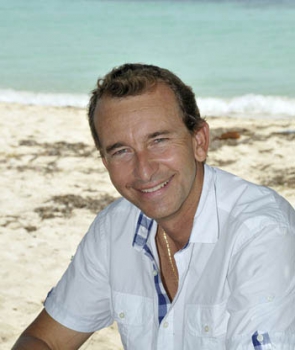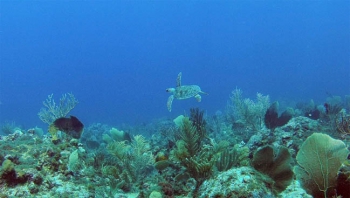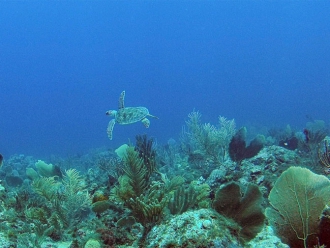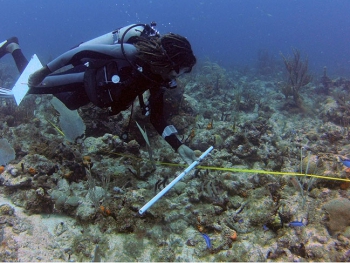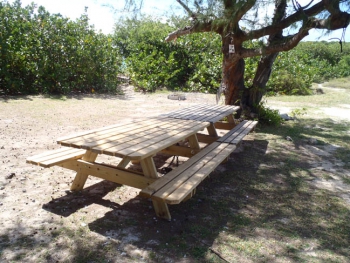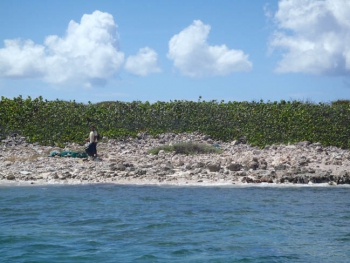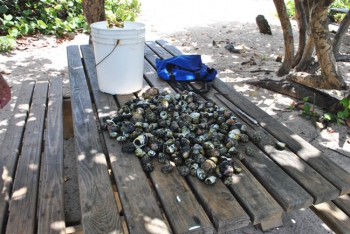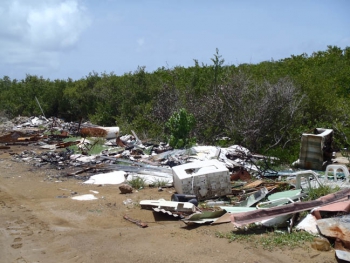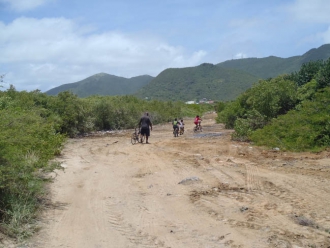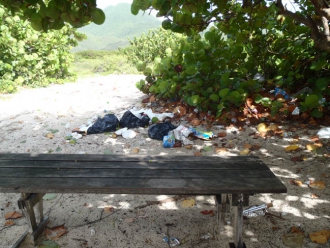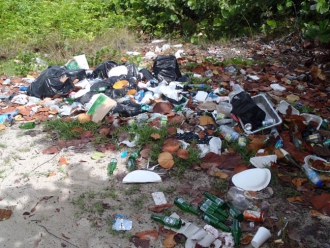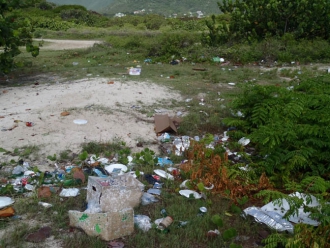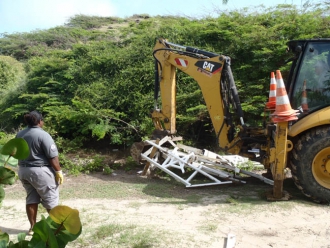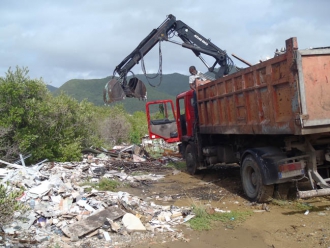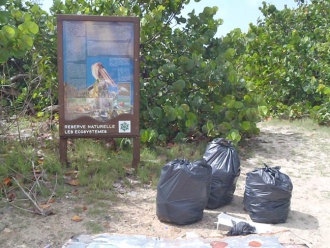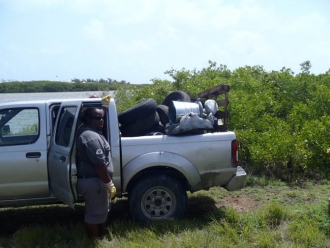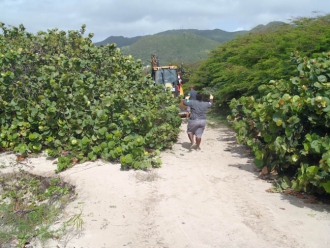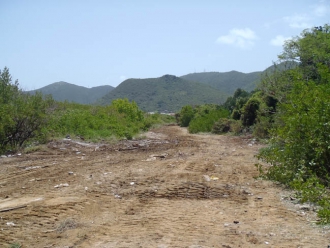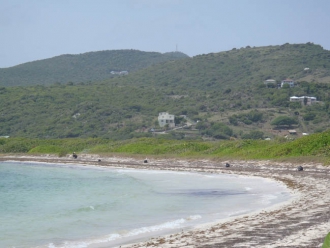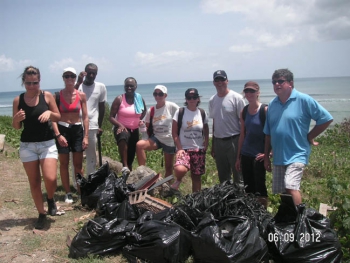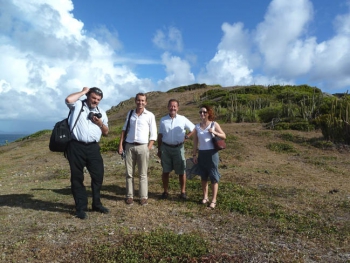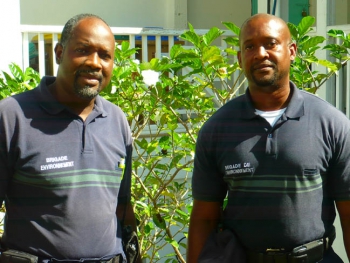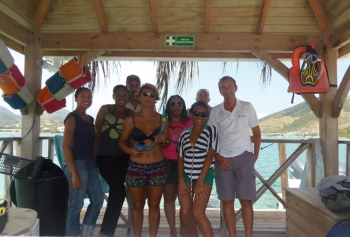Slowly but surely, interest in the environment is progressing on our island.
The proof of increased interest in the environment can be seen in the growing number of eco-volunteers taking part in our projects, as well as the large number of public and private initiatives for cleaning up the coastline, and also the important role that our natural sites are playing in the promotion of the island. However, attacks against the environment continue and are intolerable. It is only by combining environmental protection of these sites with education and vigilance, that we can work together to further the cause. Like the six agents of the Réserve Naturelle and the Conservatoire du Littoral do on a daily basis.
Newsletter-16
Newsletter-16
Better Knowledge About Protected Areas And Protected Species
The study of sea turtles laying eggs on the island’s beaches continues. The good news is that the numbers, while down in May at the beginning of the season, have shown a serious increase. The Réserve’s 60 eco-volunteers remained vigilant and noted 425 sorties and 86 instances of turtle tracks, primarily green sea turtles. In addition, several people have called the Réserve to announce the presence of baby turtles just after their appearance on the beaches of Orient Bay, Friar's Bay and Long Bay, right in front of La Samanna hotel. The baby turtles usually emerge at night and it is rare to be able to observe them as it happens.
Emergence of sea turtles: encouraging results
If you witness the emergence of turtles or are in the presence of a baby turtle on the beach, what should you do?
First, make sure that no one interferes and that no potential predators get near the young reptiles.
Keep dogs and birds out of the way, do not touch the baby turtles, and let them make their way into the sea by themselves.
Please call the Réserve Naturelle if any of the babies seem to be in danger of any sort (05 90 29 09 72). Your eyewitness reports are very valuable to us.
Every summer for the past six years, divers from the nature reserves in Saint Martin, Saint Barth, and Petite Terre in Guadeloupe were able to head into the sea to evaluate the condition of the coral reefs and sea plant beds in these three different areas, thanks to financing from DEAL in Guadeloupe. This year, the experience was repeated.
In Saint Martin, from August 30-September 9, the divers added two new monitoring stations, so that there are now four sites within the perimeter of the Réserve and two sites outside of the perimeter, the goal being to observe the overall conditions in these zones.
Taking into account the degradation in the quality of the swimming water around Pinel, special attention was paid to the reefs and plant beds this year.
The coral on one hand, and the plant beds on the other, were subject to a kind of census, with the numbers compared to those of past years.
The data is currently under evaluation and the results will be known before the end of the year.
Managing The Impact Of Human Activities In Protected Areas
The eyes of the Réserve Naturelle are turned toward the island of Tintamare, where three new wooden tables have been installed.
This makes a total of six tables that were all fabricated by the carpentry and woodworking students at the polyvalent high school for the Northern Islands.
The tables await those who want to picnic in the shade of the filao trees along the beach, just a few steps from the crystal clear water.
As requested, the agents of the Réserve installed the tables close to each other, in order to accommodate groups of up to 20 people. In order to limit the risk of a fire, two special spots have been allocated for cooking, which is otherwise prohibited.
These spots are equipped with grills that are for the use of visitors.
And as Tintamare does not just comprise the beach in Baie Blanche, the staff of the Réserve also cleaned up an area around the reefs, where they found four 200-liter containers dumped into the sea, a large fishing net and a large bale of plastic wire.
Caught while fishing in the Réserve Naturelle in the company of his father, an adolescent aged 14 - thus legally responsible - was ordered to do five half days of community service... in the Réserve.
In this case, the judicial protection service for minors signed an agreement with the Réserve Naturelle, which could eventually help other young people in similar legal situations.
In late August, the adolescent in question cleaned the beaches of Tintamare, Grandes Cayes, Galion, and Pinel, in the company of a ranger. In addition, his final half day was spent on the Réserve’s boat for a session dedicated to environmental education, during which time a park ranger instructed him about the protection or marine flora and fauna, and the importance of respecting the rules and regulations.
1500 euros for a bucket of sea snails
Three poachers were held accountable to the gendarmerie’s nautical brigade after rangers from the Réserve stopped them on the beach in Grandes Cayes on July 10, 2012.
The three men had been fishing for sea snails at the Wilderness site and were carrying a bucket containing more than a hundred of these mollusks, in spite of the fact that fishing is prohibited in the Réserve.
The sea snails were put back into the sea, and the poachers were accused of illegal fishing in the Réserve Naturelle.
While awaiting their sentencing in court, they risk a fine of 1500 euros each.
Two kite-surfers accused
The Réserve Naturelle would like to remind everyone that kite surfing is prohibited in the Baie de l’Embouchure, as per an official ruling from the prefecture. In spite of this, certain individuals have not given up trying, even after several warnings by Réserve rangers.
For example, a kite-surfer was caught at Galion, after he took off from the busiest part of the beach on July 10, 2012.
His dossier was sent to the nautical brigade at the gendarmerie, which will convoke the offender.
Shortly thereafter, on August 10, 2012, an instructor who gave kite-surfing courses at Galion, was accused for the second time for practicing a sport forbidden within the Réserve Naturelle.
He was called before the nautical brigade at the gendarmerie.
Fishing gear confiscated
On July 6 off the coast near Grandes Cayes, and again on July 19 near Rocher Créole, a guard stopped two spear fishermen for illegal fishing within the marine park.
Their gear, immediately seized, was returned to them the next day in exchange for a copy of a piece of identification.
The fish they caught were also confiscated.
Jet-skis in the Réserve: a no-no!
The manager of a jet-ski rental company, out with a client aboard a second jet ski, was surprised by Réserve rangers between Pinel and the Pointe des Froussards, on September 3, 2012.
A report was made and sent on to the nautical brigade.
Restoration Of Degraded Areas And Populations
It took four days for 10 agents from the Collectivity, three rangers and the director of the Réserve Naturelle to get to the bottom of the trash dumped at Galion, but the result was worth the wait.
The Collectivity provided a truck with a crane and a backhoe in order to clean the entire site, comprising the beach, the area behind the beach and the dirt path that leads to French Quarter.
Those on the clean-up squad worked like demons to collect 20 tons of diverse trash—forgotten items from picnics, old cans, appliances, rubble, car bodies, building materials, old furniture—that was accepted free of charge at the eco-site at Grandes Cayes. Large volcanic rocks have been put in several places to impede future access by vehicles.
Thursday, September 6 was World Cleanup Day for all the Radisson Hotels around the world, and the Radisson in Anse Marcel decided to spend the day cleaning up the beach at Petites Cayes and the Chemin des Froussards, both located in the heart of the Réserve Naturelle.
Equipped with garbage bags, a dozen employees of the hotel —including the general director—followed the path that their clients regularly go on, along with two rangers from the Réserve.
They picked up every little bit of trash they could find during a two-hour walk.
Although the site was not overly polluted, the hotel workers managed to fill several trash bags and remove some larger items that had washed up on shore and eventually all was taken to the trash collection eco-site at Grandes Cayes.
Better Means For Better Missions
The Conservatoire du Littoral, whose role is to protect natural sites and coastlines in France by shielding them definitively from construction, also plays a role in Saint Martin, where it owns and protects 355 hectares (almost 880 acres) on the island.
The sites include 14 salt ponds (roughly 200 hectares), natural coastlines (about 85 hectares, comprising all adjoining land that is classified with the nature preserve), and finally the outlying islands (Pinel, Tintamare, Petite Clé, Caye Verte, Rocher Créole, Rocher de l’Anse Marcel and Grand Ilet in the Simpson Bay lagoon). In addition to protecting the land, the Conservatoire also improves these areas, working to conciliate their preservation with public usage: from restitution of deteriorated eco-systems to improvements for the public (botanical paths, observatory, shelters…).
The management of these sites has been entrusted to the Réserve Naturelle, which works hand-in-hand with the Conservatoire.
Working in Saint Martin from July 16-20, 2012, the Conservatoire’s overseas delegate, Marc Duncombe, took a look at all the ongoing dossiers.
Accompanied by Romain Renoux, director of the Réserve and representative of the conservatoire in Saint Martin, and by Béatrice Galdi, responsible for Conservatoire in Saint Martin and Saint Barthélemy, Duncombe first met with prefect Philippe Chopin, who invited him to attend next Conseil des Rivages Français d’Amérique (CRFA), to be held in Saint Martin and Saint Barth in April 2013.
Duncombe also met president Alain Richardson -who, along with Christophe Hénocq, represents the Collectivity at the CRFA- and discussed the challenges of the Conservatoire on the island, including the important issue concerning the expropriation of land with the ruins of a hotel near Galion Beach, with an eye toward rehabilitation of the site. Within the framework of another project, Duncombe met with the president and vice-president of the Association Syndicale Libre of Oyster Pond (ASLOP) and reconfirmed the Conservatoire’s interest in the site at Babit Point, which partially belongs to the ASLOP.
Of great environmental interest, this site houses an important colony of melocactus -or Turk’s Head cactus- a protected species native to the Lesser Antilles.
Duncombe also met with the directors of the two restaurants that have temporary authorization along the coastal area belonging to the Conservatoire on the island of Pinel.
He agreed there were good environmental practices in place for this site for several years now.
Concerning the protection of the salt ponds, Duncombe expressed his concerns about runoff and purification of gray water in relation to the anticipated installation of several water treatment plants whose runoff could impact several of the ponds.
In principal, the Conservatoire is not opposed to such installations, but it needs guarantees about the quality of the water treatment and the maintenance of the installations, so that they do not in any way have a negative effect on the overall health of the ponds. Duncombe also expressed interest in other ongoing projects such as the whale-watching observatory near Coralita, and just a few steps away, the land recently cleaned up at the mouth of the Etang aux Poissons.
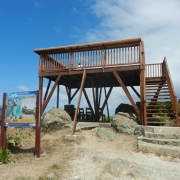 The whale-watching observatory near Coralita © Conservatoire du littoral
The whale-watching observatory near Coralita © Conservatoire du littoralThis is a site where the Conservatoire, in conjunction with the Réserve and the Collectivité, has plans for an environmental restoration project with public access.
Albert Minville, in charge of the land part in the territorial environmental brigade, and Michel Hamlet, in charge of the beaches, are now also littoral rangers as well, are now also littoral rangers as well.
At the suggestion of the Conservatoire du Littoral, these rangers completed commissioning training financed by the Temeum program.
They increased their judicial knowledge in terms of infractions to the environmental code, and have been invested with the same powers as the police.
They were presented with their commissions and their badges by Marc Duncombe, who congratulated them for their success, and their commitment to the protection of the littoral. A cocktail toast for the staff from the territorial direction for the environment; Romain Perreau, head of the sustainable development service at the prefecture; Jean-David Richardson, territorial counselor; and the staff of the Réserve Naturelle and its president followed the informal ceremony.
Environmental Communication And Education
Romain Renoux, director of Réserve Naturelle, invited a first group of five employees from the Tourist Office to take a day’s holiday in the Réserve Naturelle.
On September 6, as they played at being tourists on the boat belonging to the Réserve, these tourism professionals visited Tintamare, Rocher Créole, Caye Verte and finally Pinel, where everyone in the small group dove under the waves along the underwater trail.
This informal excursion will be renewed for all of the tourist office personnel with an eye toward a better understanding of the island’s natural resources for those who come into contact with visitors on a daily basis.
This event also allowed Renoux to show off the various items provided by the Réserve —picnic tables, shelters, signage and moorings…as well as by its partners— boat rentals, diving clubs, nautical sports…
Over 40,000 tourists visited the Réserve Naturelle in 2011 and helped pay for its financing through the 1.52 euro fee paid per person per day. The fee is collected for the Réserve via its partners.

